Mount Sinai & Surrounding Areas
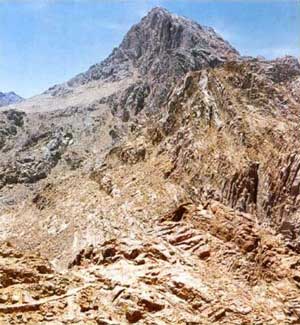 |
| The Gate
of Confession on Mount Sinai |
Many people who visit St. Catherine's Monastery are
unaware of many of the other interesting religious and other
sites within the southern Sinai, as well as the region's natural
wonders. Specifically, this area of the Sinai has a history,
beginning with the Jewish Exodus, as an important religious
center with visible ruins that date back considerably prior
to the establishment of the Monastery of St. Catherine.
Of course, anyone visiting the monastery is aware
that it is situated at the foot of Mount Sinai, but there
are a number of other locations that are also worth knowing
about and visiting in the region.
While any number of other locations have been suggested
as Mount Sinai (also known as Mount Horeb and today, Jebel
Musa) of the Bible, very old traditions maintain that the
mountain that rises dramatically above the Monastery of St.
Catherine is in fact the true site where Moses received the
Ten Commandments. In the valleys surrounding the mountain
are also any number of other sites long held to be holy places
connected with the biblical story of the Exodus, as well as
from later times when biblical figures such as Elijah returned
to the mountain (between 900 and 800 BC).
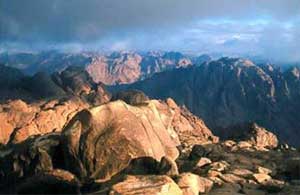 |
| View fron
the top of Mount Sinai |
It is doubtful that anyone today is aware of the
specific evidence that convinced so many very early hermits
to establish themselves in the vicinity of Mount Sinai, though
oral and other traditions dating much further back probably
played a role. By Egyptian standards, the biblical Exodus
can be said to have occurred actually rather late in their
history, probably between 1,500 and 1,200 years before the
time of Christ. There were certainly even then the same race
of Bedouins, as well as other Egyptians scattered throughout
the Southern Sinai, who would have known about and even had
contact with the wandering Jews. It would seem logical that
they would have been the ones who maintained the traditions
that would later define specific sites as some of the most
holy places mentioned in the Bible.
While the earliest ruins we know of in this region
of the Sinai date to the 4th century, it is not impossible
that earlier religious sites do exist in this rocky, mostly
desolate landscape.
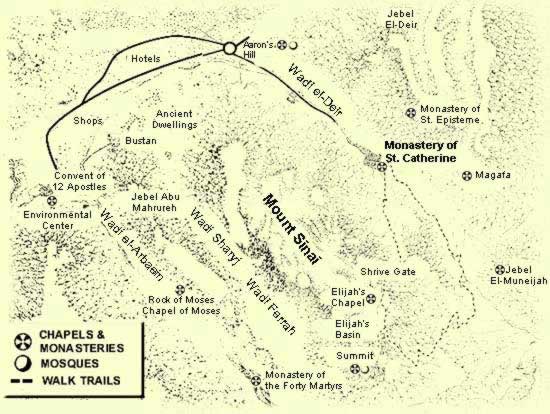 |
| Map of the Region around St. Catherine's Monastery |
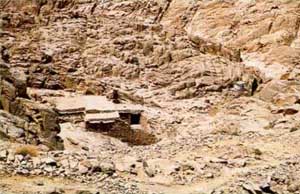 |
| Ancient
chapel dedicated to Elijah below the summit of Mount
Sinai on Elijah's Basin |
At Mount Sinai, a long flight of 3,700 steps, hand
hewn from the stone by the monastery monks, leads to the peak
of the mountain. Writing in the 4th century, Etheria explains
that in his time the stairway extended only part way up the
mountain, and perhaps this early section of the stairway was
carved out in the 4th century, but their origin, and exactly
when they were built is lost to us. Records of the monastery
reveal that they were completed by an anonymous monk under
the patronage of Emperor Justinian in the 6th century.
The stairway is known as the "Stairs of Repentance".
Mount Horeb is of special importance by reason of the "Peak
of the Decaloque". A church consecrated to the Prophet Elijah
was built on this peak during ancient times, and Ephraim the
Deacon in the 4th century records the existence of twelve
chapels on the slopes and summit of Mount Horeb.
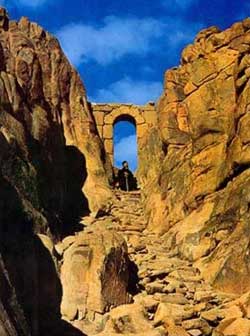 |
| Gate of
Confession on Mount Sinai |
Along the stairway one passes a number of historical
sites. For example, the first significant one is known as
the Spring of Symeon, where Saint Stephen supposedly baptized
Jews so that they could pass through the Shrive Gate further
up on their way to the Holy Mount. However, prior to reaching
the Shrive Gate (The Gate of Forgiveness or Gate of Confession),
one passes by the White Washed Byzantine chapel about halfway
up the mountain known as the Chapel of Our Lady of the Steward
(Oikonomissa). Still further up is Elijah's Gate and beyond
that, Elijah's Basin. Here on a sandy surface, is an ancient
well and below the well, a Byzantine dam built to prevent
flood damage to the Monastery. There is also the chalky white
Church of Elijah, which is built over a stone beneath which
Elijah is said to been sheltered when he spoke with God (I
Kings 19:1-18). Here also, about 200 meters from the other
church at the neck of the basin is the Church of Saint Stephen,
which is believed to mark the cave where Saint Stephen lived.
His cloaked, 6th century remains are now in the ossuary at
the Monastery.
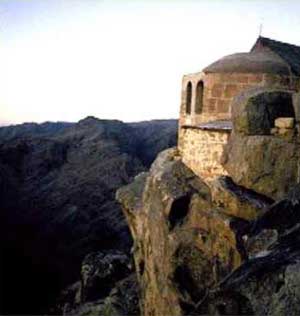 |
| The Chapel on top of
Mount Sinai |
At the top of Mount Sinai, a church was built on
this site very early, possibly in the 4th century, and rebuilt
later under Justinian on plans by the architect Stephanos.
Today, only the foundation of the old church remains, which
was fairly large, measuring 21 meters in length and 11.5 meters
wide. In 1933, a small chapel dedicated to the Holy Trinity
was raised over part of the ruins of the Justinian church,
and there is also an ancient mosque built on the peak. Both
of the newer structures were built partly from blocks of the
older church.
The alternate path up the mountain is by camel, and
it too passes by a number of interesting sites. The camel
path up Mount Sinai begins just behind the monastery and leads
up to just short of Elijah's Basin.
Some distance up this path leads past a small mountain
or hill known as Jethro's Mountain or Jebel El-Muneijah. This
is the site where Jethro and his daughters were supposed to
have lived when Moses first came to Mount Sinai. On its summit
is a small white church dedicated to Saint Theodore the Commander
and Saint Theodore the Tyro (Recruit), both martyred Roman
soldiers.
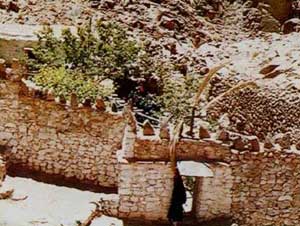 |
|
The hermitage of St.
Epistene |
This path continues to twist its way up the mountain
until almost reaching Elijah's Basin, but looking about on
the way up, one can discern other sites on nearby mountains.
Opposite the Monastery, on the Mount of St. Episteme,
also known as Jebel el-Deir, are a hermitage and a chapel
dedicated to St. Episteme, as well as a cave in the name of
St. Galaktion. The monastery is located about half way up
the mountain. To the south of these structures and east southeast
of the Monastery is another small monastery known as Magafa,
which is nestled amid date palms and Byzantine walls.
To the north of the Monastery of St. Catherine leading
to the northwest is Wadi el-Deir, along which the road to
the monastery runs. The stone ruins just to the north of this
road as one approaches the monastery date only to the mid
19th century. They are the barracks built for Abbas Pasha's
soldiers and workers.
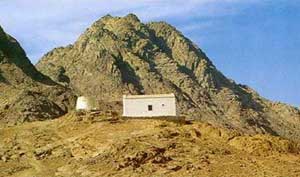 |
| The Chapel of the Prophet
Aaron |
A little further north and close to the village of
St. Catherine is Aaron's Hill, Here, there is both a Christian
Church and a Muslim Shrine. According to tradition, the Golden
Calf was set up and worshipped on this hill. Just to the north
of the hotels of the village is the Plain of El-Raha, meaning
resting place, where supposedly Aaron and the Israelites made
the golden calf while Moses was on Mount Sinai.
To the south of the hotels is a location known as
Bustan, where there is a chapel honoring the Birth of the
Virgin Mary. Southwest of this is an environmental center
and nearby is the convent of the 12 Apostles.
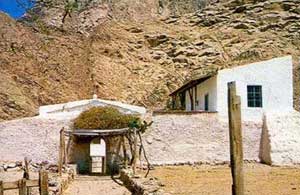 |
|
The chapel
honoring the Birth of
the Virgin Mary at Bustan |
Further south along the Wadi el-Arbaein, that lies
on the opposite side of Mount Sinai from the Monastery of
St. Catherine, is the Chapel of the Prophet Moses and next
to it is a stone wall which encloses the "Rock of Moses".
Monks relate that this rock relates to the time of the Exodus
and is described in 1 Cor. 10:4.
Still further south along the wadi is the Monastery
of the Forty Martyrs, surrounded by a green belt of olive,
cypress and poplar trees. This monastery was built during
the 6th century in honor of the forty Christian martyrs, Roman
soldiers, who died at Sebaste in central Turkey. In the garden
of the monastery is the chapel of St. Onouphrios, who is said
to have lived for seventy years in the rock shelter at the
northern end of the garden, until he died in the late 4th
century AD.
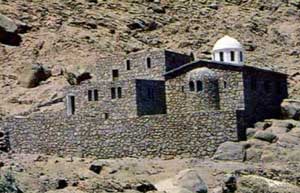 |
| The Chapel dedicated to St. John Climacus |
Another route just to the south of the hotels at
the village of St. Catherine leads into the Wadi Shrayj, which
later connects to Wadi Ferrah further to the south. Here,
not far south of the hotels are rounded walls, niches and
shelves and tiny doors that make up typical Byzantine stone
dwellings. One can also see traces of ancient water systems
or conduits that are typical of the Byzantine era. A bit further
south up this wadi are more Byzantine ruins and a few ancient
Nabatean structures that date from between 200 BC and 100
AD.
About five miles from the Monastery is the well known
Valley of Thola, where one finds preserved to this day a cave
and chapel that were the retreat of the celebrated St. John
Scholasticus, perhaps better known as St. John Climacus after
his renowned work. In the same area is a dependency of St.
Catherine's Monastery known as Saints Anargyroi.
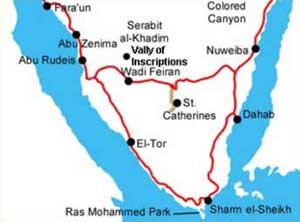 |
| Map of
the Southern Sinai |
In the same general area near the Monastery but beyond
Mount Sinai is the Mount of St. Catherine, where there is
a chapel dedicated to St. Catherine on the site. Traditions
hold that the Saint's body was found. Mount Catherine is the
highest in the Sinai Peninsula, towering some 8,700 feet above
sea level. The mountain is not difficult to ascend and its
peak offers a magnificent view south to the Red Sea and Gulf
of Aqaba.
Somewhat further away to the northwest of the Monastery
is the famous Wadi Feiran.(Wadi Faran) which is actually the
largest oasis in the Sinai. It once had the privilege of being
the See of the first Bishopric of the Sinai Peninsula. The
latest excavations at Feiran have brought to light the foundations,
the floor and the ruined wall of the ancient church and annexes.
This was the place mentioned in Genesis 21:21 as the site
where Hagar dwelt with her son after Abraham sent her away.
Today, there is a fine and interesting convent, as well as
other sites with historical significance in the area.
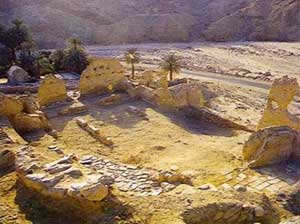 |
| The ruins of the ruined
basilica
at Wadi Feiran |
A little north of Wadi Feiran is Wadi Mukattab, also
known as the Valley of Inscriptions, which has Byzantine graffiti.
Present day El-Tor is not much visited by foreign
tourists, but this is ancient Raitho where, during the time
of the Roman emperor Diocletian, the Holy Fathers of the Sinai
were massacred by the Blemmyes of Africa. Not much is left
here, but a letter addressed by the Abbot John Hegoumenos
of Raitho to "John the most worthy Hegoumenos of Mount Sinai"
has survived. From this we learn that at the time of the Abbot
John there was a lavra (a group of hermit dwellings) at Raitho.
Today, one can still see the ruins of a monastery built by
Justinian, and there is also a more recent monastery with
a splendid church and a guest house.
Here, we have concentrated mostly on religious sites,
though we have not mentioned every chapel even in the region
around Mount Sinai, as there are a number of other sites that
are difficult to place. Furthermore, it should be mentioned
that there are various mines, quarries, pharaonic ruins, and
more modern sites, as well as natural wonders in this region
that are beyond the scope of this description. For example,
Serabit el-Khadem, which has mines and a temple is within
the Valley of Inscriptions.
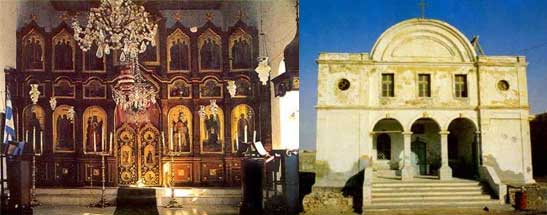 |
| Interior and exterior
of the Church of St. George at El-Tor |
Egypt's Southern Sinai in and around the Monastery
of St. Catherine is a wonderful place to experience Christianity's
roots, as well as biblical sites dating back to the very foundations
of Judaism. Taking a few extra days to explore the region
may provide surprising finds in this land that continues to
hold gems of hidden beauty and wonder.